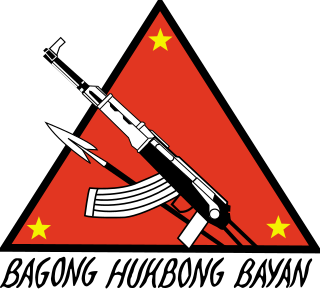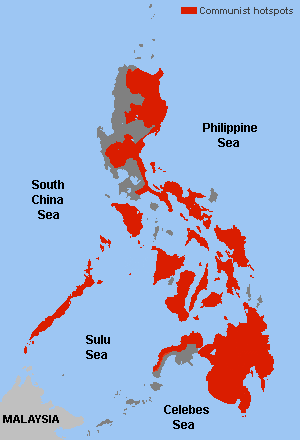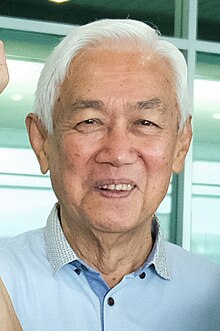
The New People's Army, abbreviated NPA or BHB, is the armed wing of the Communist Party of the Philippines (CPP). It acts as the CPP's principal organization, aiming to consolidate political power from what it sees as the present "bourgeois reactionary puppet government" and to aid in the "people's democratic revolution". Founded on March 29, 1969, by the collaboration of Jose Maria Sison and former members of the Hukbalahap led by Bernabe Buscayno, the NPA has since waged a guerrilla war based on the Maoist strategy of protracted people's war. The NPA is one of the key figures in the ongoing Communist rebellion in the Philippines, the longest ongoing conflict in the country.

The Communist Party of the Philippines (CPP) is a far-left, Marxist–Leninist–Maoist revolutionary organization and communist party in the Philippines, formed by Jose Maria Sison on 26 December 1968. It is designated as a terrorist group by the United States Department of State together with Sison and its armed wing New People's Army (NPA) in 2002. The European Union renewed its terrorist designation on the organization in 2019, though a 2009 ruling by the EU's second highest court delisted Sison as a "person supporting terrorism" and reversed a decision by member governments to freeze assets. According to the US' Central Intelligence Agency (CIA) World Factbook, the CPP and the NPA aims to destabilize the Philippines' economy and overthrow the national government.

Jose Maria Canlas Sison, also known as Joma, was a Filipino writer, poet, and activist who founded and led the Communist Party of the Philippines (CPP) and added elements of Maoism to its philosophy—which would be known as National Democracy. His ideology was formed by applying Marxism–Leninism–Maoism to the history and circumstances of the Philippines.

The National Democratic Front of the Philippines (NDFP) is a coalition of revolutionary social and economic justice organizations, agricultural unions, trade unions, indigenous rights groups, leftist political parties, and other related groups in the Philippines. It belongs to the much broader National Democracy Movement and the communist rebellion in the Philippines.

The Order of Augustinian Recollects (OAR) is a mendicant Catholic religious order of friars and nuns. It is a reformist offshoot from the Augustinian hermit friars and follows the same Rule of St. Augustine. They have also been known as the "Discalced Augustinians".

Alberto Ramento y Baldovino was the ninth supreme bishop and a former chairperson of the Supreme Council of Bishops of the Philippine Independent Church or Iglesia Filipina Independiente (IFI). He was known by the moniker, "The Bishop of the Poor Peasants and Workers".

The New People's Army rebellion is an ongoing conflict between the government of the Philippines and the New People's Army (NPA), which is the armed wing of the Marxist–Leninist–Maoist Communist Party of the Philippines (CPP). It is the world's longest ongoing communist insurgency, and is the largest, most prominent communist armed conflict in the Philippines, seeing more than 43,000 insurgency-related fatalities between 1969 and 2008. Because the National Democratic Front of the Philippines (NDFP) which is the legal wing of the CPP, is often associated with the conflict, it is often also called the CPP-NPA-NDF conflict, or simply the C/N/N conflict, especially in the context of peace talks with the Philippine government.

The history of communist armed conflicts in the Philippines is closely related to the history of Communism in the Philippines, with various armed conflict linked to the armed wings of the various communist organizations that have evolved since 1930. The two largest conflicts have been the Hukbalahap Rebellion of 1942–1954, and the ongoing rebellion of the New People's Army, which began in 1969 under the auspices of the Communist Party of the Philippines (CPP). But various splinter groups have since separated from the CPP and have had a history of armed conflict with the Philippine government since then.
The following is the timeline of events of CPP-NPA-NDF rebellion, a conflict between the government of the Philippines, the Communist Party of the Philippines (CPP), the New People's Army (NPA) and the National Democratic Front (NDF).

Kabataan, also known as the Kabataan Partylist and formerly known as Ang Nagkakaisang Kabataan Para sa Sambayanan, is a partylist in the Philippines affiliated with the leftist political coalition Makabayan. It is currently represented by Raoul Manuel at the Philippine Congress since 2022. According to its website, the partylist represents the youth sector, and aims to "galvanize the Filipino youth’s unity for social change," believing that the youth should "devote its intellect, energy, and courage to building a new society devoid of corruption, inequality, and social injustice."
The Second Great Rectification Movement refers to a 1992 ideological campaign initiated by the leadership of the Communist Party of the Philippines (CPP) wherein an effort was made to "identify, repudiate and rectify the errors of urban insurrectionism, premature big formations of the New People's Army and anti-infiltration hysteria". The rectification movement resulted in the once monolithic Filipino communist party fragmenting into at least eight warring factions during the 1990s.
Antonio Maria "Tony" Onrubia Nieva was a Filipino journalist, union organizer, and activist. He worked to defend press freedom and the rights of workers, and campaigned to end authoritarian rule in the Philippines. He led the National Press Club as president and founded the National Union of Journalists of the Philippines. He was secretary general of the International Organization of Journalists based in Prague, Czech Republic, from 1995 up to the time of his death in 1997. His name is on the Bantayog ng mga Bayani Wall of Remembrance, for his contributions to the fight against injustices of the dictatorship under President Ferdinand E. Marcos.
Religious sector opposition against the dictatorship of President Ferdinand Marcos included leaders and workers belonging to different beliefs and denominations.
Red-tagging in the Philippines is the malicious harassment and blacklisting of individuals or organizations critical or not fully supportive of the actions of a sitting government administration in the country. These individuals and organizations are "tagged" as either communist or terrorist or both, regardless of their actual political beliefs or affiliations. It is a type of incitement and has pernicious effects on its targets. Red-tagging may be performed by either security forces, government officials or shills.
Fidel V. Agcaoili, also known as Ka Fidel, was a Filipino activist and revolutionary. He was a member of the Communist Party of the Philippines' Central Committee, along with Jose Maria Sison and Luis Jalandoni during the Marcos dictatorship. In 1974, he was arrested and became the longest detained political prisoner under Marcos, being imprisoned for 11 years. On his release, Agcaoili founded the Samahan ng mga Ex-Detainee Laban sa Detensyon at Aresto (SELDA), a prisoners' rights organization.
Antonio De Leon Zumel II, also known by his nicknames Tony, Manong, Ching and Antumel, was a Filipino journalist, activist, and ;eftist revolutionary. He was two-time President of the National Press Club of the Philippines before going underground in 1972 at the start of the Marcos dictatorship. In 1990, he was elected Chairperson of the National Democratic Front of the Philippines in absentia, and was a senior adviser to the NDFP negotiating panel from 1994 until his death in 2001.

Patricia Fox is an Australian religious, a member of the Congregation of Our Lady of Sion. She is known for her ejection from the Philippines by president Rodrigo Duterte. Prior to this, she was the National Coordinator of the Rural Missionaries of the Philippines.

Rafael Ledesma Jalandoni was a Philippine Constabulary officer who served as the 3rd Chief of Staff of the Armed Forces of the Philippines. He was appointed by President Manuel Roxas in 1946 after gaining independence from United States. He retired in 1948. He served as an aide of President Manuel L. Quezon in pre-war years.
Revolution Selfie: The Red Battalion is a 2017 documentary film that follows director Steven de Castro in travelling to the Philippines to meet with the New People's Army. The film is notable for being shot almost entirely from first-person point of view in part simulated video gameplay.











